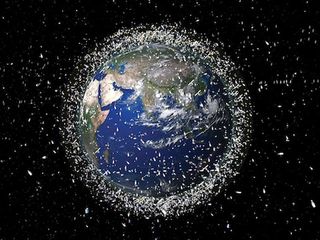The world needs space junk standards, G7 nations agree
Space debris was on the agenda at the G-7 Leaders' Summit in Cornwall, U.K.

Leading industrial nations have agreed to make the space junk problem a priority in order to ensure future sustainable use of space. The announcement, made at the G-7 Leaders' Summit in Cornwall, U.K., on Sunday (June 13), has been hailed by representatives of the commercial space industry and experts alike as a major milestone.
Delegates from Canada, France, Germany, Italy, Japan, the U.S., the U.K. and the EU, have agreed to focus on the development of common standards of sustainable operations as well as space traffic management and coordination.
They also called on other nations to follow the United Nations' Long-term Sustainability Guidelines, which outline best practices in the use of space.
"There is an urgent need to stabilize global space operations," Simonetta Di Pippo, director of the U.N. Office for Outer Space Affairs, said in the G-7 statement. "We must future-proof activities now to deliver a safe, secure and sustainable space environment for tomorrow. I welcome this clear commitment by G-7 leaders to put space sustainability at the heart of the political agenda."
Related: How are asteroids, space weather and space debris detected before they hit Earth?
Space debris is a worsening problem for the international space community. According to the European Space Agency (ESA), there are approximately 34,000 space debris pieces larger than 4 inches (10 centimeters) currently orbiting Earth, as well as around 900,000 fragments between 0.4 and 4 inches (1 to 10 cm) and a staggering 128 million objects between 0.04 and 0.4 inches (1 millimeter to 1 cm).
Each of these items hurtles uncontrolled through space at 17,500 mph (28,000 kph), posing serious hazards to the safety of functioning satellites. The problem is bound to get worse with the rise of megaconstellations such as SpaceX's Starlink, which introduce tens of thousands of additional satellites into the already cluttered orbital environment.
Get the Space.com Newsletter
Breaking space news, the latest updates on rocket launches, skywatching events and more!
"As the orbit of our planet is a fragile and valuable environment that is becoming increasingly crowded, which all nations must act together to safeguard, we agree to strengthen our efforts to ensure the sustainable use of space for the benefit and in the interests of all countries," the countries said in the statement. "We are committed to the safe and sustainable use of space to support humanity's ambitions now and in the future and recognize the growing hazard of space debris and increasing congestion in earth's orbit."
Astroscale UK, the U.K. subsidiary of Astroscale Holdings, which is developing commercial space debris removal services, commented on the announcement:
"We're delighted that space sustainability is receiving high level attention with G-7 leaders," Astroscale UK's Managing Director and Group Chief Commercial Officer, John Auburn said in the company's statement. "Space debris is a very real challenge for governments and large constellation satellite companies, to tackle the problem requires national support for globally agreed norms of behavior, political leadership and partnership between the private sector and governments to protect space for future generations and start cleaning up space now."
Tim Peake opens first commercial deep space antenna as part of G-7 summit
In a separate development in the framework of the related space industry G-7 Green Futures conference, European Space Agency (ESA) astronaut Tim Peake opened the world's first commercial deep-space antenna, located at the Goonhilly Earth Station complex, also in Cornwall.
The antenna will support Intuitive Machines, a Texas-based company developing lunar exploration landers, during their 2022 IM-1 mission to the moon through NASA's Commercial Lunar Payload Services launch program.
Goonhilly Earth Station, at one time the largest radio communications station in the world, announced it would upgrade some of its facilities for deep-space communication in 2018. The $11.85 million (£8.4 million) upgrade, which was funded by Cornwall and Isles of Scilly Local Enterprise Partnership, the U.K. Space Agency and ESA, will support future missions to Mars and the moon.

The antenna has undergone months of testing with ESA's Mars Express orbiter. During that process, the antenna sent the first transmissions to Mars from U.K. soil — and the first anywhere in the world by a privately owned company.
"Goonhilly has built an incredible team to complete the upgrade over the last three years," Matt Cosby, chief technology officer of Goonhilly Earth Station said in a statement. "The project involved a refurbishment of the antenna, replacing the motors, gearboxes and thousands of bolts on the structure. The complete workings of the communications system has been completely replaced to allow us to seamlessly connect to ESA's control center, where they are able to send commands to Mars and receive their data from the spacecraft."
Follow Tereza Pultarova on Twitter @TerezaPultarova. Follow us on Twitter @Spacedotcom and on Facebook.
Join our Space Forums to keep talking space on the latest missions, night sky and more! And if you have a news tip, correction or comment, let us know at: community@space.com.

Tereza is a London-based science and technology journalist, aspiring fiction writer and amateur gymnast. Originally from Prague, the Czech Republic, she spent the first seven years of her career working as a reporter, script-writer and presenter for various TV programmes of the Czech Public Service Television. She later took a career break to pursue further education and added a Master's in Science from the International Space University, France, to her Bachelor's in Journalism and Master's in Cultural Anthropology from Prague's Charles University. She worked as a reporter at the Engineering and Technology magazine, freelanced for a range of publications including Live Science, Space.com, Professional Engineering, Via Satellite and Space News and served as a maternity cover science editor at the European Space Agency.
